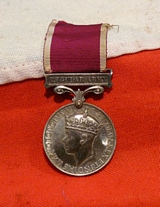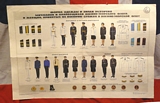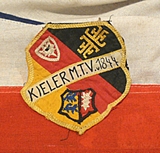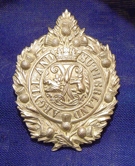A Khedive Star Medal
Five pointed star with a central raised circle bearing an image of the Sphinx with the Pyramids behind, the word ?EGYPT? above followed by a year (for the first three issues and undated for the fourth) with the same written in Arabic below. The reverse has the monogram of the Khedive under a crown within a raised circle. The Khedive of Egypt presented a bronze star to all Officers and men of the Navy and Army who were engaged in the suppression of the rebellion of Egypt in 1882. The suspender [lacking] was straight with a crescent and five pointed star in the centre which is attached to the star with a small metal loop passing through a small ring between the two top points of the star. Ist issue dated 1882. Good Very Fine condition. No ribbon,mount.Unnamed as issued. read more
65.00 GBP
George VIth Long Service Good Conduct Silver Medal
Regular Army bar. Very good condition denamed. Awarded to WW2 & Korean War Regular Army soldiers and officers for at least 18 years unblemished service in the British Army. read more
95.00 GBP
A Good Russian Cold War Era Poster
Original poster with interesting subject matter of military and maritime uniforms and ranks. This is one of a collection of Russian USSR posters we have acquired from the estate of an ex British Glider Pilot of WW2. This poster is folded and in condition as seen in the photos. 36.5 inches x 24 inches. This poster is a real and used item, not just for show, would look super nicely framed read more
145.00 GBP
Armoury Antiques and Militaria. The Lanes Armoury Best Militaria Shop in The Uk
An Original Police Badge for the Seattle Police , USA From a collection we have just acquired from a now closed small private Police museum.4inches x 4.5 inches read more
9.00 GBP
A Scarce WW2 German Sports Badge
Badge of the sports and gymnastics club Kieler M?nnerturnvereins von 1844. Woven cloth shield in Blue Red and Gold. An offshoot of this club formed the Kiel Football club the Kieler Sportvereinigung Holstein von 1900 e.V, just after WW1, and they continued to play successfully right until the end of WW2. This badge came as a WW2 souvenir from a British Serviceman of WW2, who fought in Germany until 1945, and then transferred to the Military Police to continue to serve during the occupation till 1947. He was stationed in Schleswig-Holstein, Germany. It was worn in conjunction with the Nazi Sports badge, which is also for sale in our gallery read more
55.00 GBP
Argyll and Sutherland Highlanders Glengarry Badge 1882 to 1900 Pattern
In pressed nickel with good clear definition and in good condition, 2 lugs. read more
45.00 GBP
US Army WW2 Garrison Cap, Khaki, Officer's Tropical Issue
With Quarter Master label, dated June 1945. Pattern date 1942. Good condition. read more
30.00 GBP
French 1830'S Shako Helmet Plate
Brass plate of Cockerel and stamp of 'Return to Liberty' July 1830 read more
90.00 GBP
French 1830's Shako Helmet Plate.
Copper plate of a Cockerel over French symbols. read more
90.00 GBP










